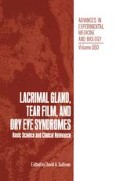Abstract
In the lacrimal gland, cholinergic agonists produce 1,4,5-inositol trisphosphate (1,4,5-IP3) and concomitantly diacyglycerol (DAG) from the hydrolysis of phosphatidylinositol bisphosphate1. 1,4,5-IP3 causes the release of intracellular Ca2+ which causes secretion1. DAG activates protein kinase C (PKC). It has not been determined if cholinergic agonists produce DAG although cholinergic agonists transiently translocate PKC activity and the PKC isozyme PKC-ε from the cytosol2.
Access this chapter
Tax calculation will be finalised at checkout
Purchases are for personal use only
Preview
Unable to display preview. Download preview PDF.
References
D.A. Dartt, D.M. Dicker. L.V. Ronco, I.M Kjeisen, R.R. Hodges, and S.A. Murphy, Lacrimal gland inositol trisphosphate isomer and tertrakisphosphate production, Am. J. Physiol. 259:G274 (1990).
R.R. Hodges, D.M. Dicker, P.E. Rose and D.A. Dartt, α1-Adrenergic and cholinergic agonists use separate signal transduction pathways in lacrimal gland, Am. J. Physiol. 262:G1087 (1992).
J.W. Putney, Jr., Phosphoinositides and alpha-1 adrenergic receptors, in: “The Alpha-1 Adrenergic Receptor,” R. R, Ruffolo, Jr. ed., Humana Press, Clifton, NJ (1987).
D.A. Dartt, L.V. Ronco, S.A. Murphy, and M.F. Unser, Effect of phorbol esters on rat lacrimal gland protein secretion, Invest. Ophthalmol. Vis. Sci. 29:1726(1988).
M.M. Bradford, A rapid and sensitive method for the quantitation of microgram quanities of protein utilizing the principle of protein-dye binding, Anal. Biochem. 72:248.
D.A. Dartt, R.R. Hodges, and D.M. Dicker, Protein kinase C, PKC-ε, and Ca2+ in cholinergic activation of lacrimal gland protein secretion, Submitted.
Author information
Authors and Affiliations
Editor information
Editors and Affiliations
Rights and permissions
Copyright information
© 1994 Springer Science+Business Media New York
About this chapter
Cite this chapter
Hodges, R.R., Dicker, D.M., Dartt, D.A. (1994). Role of Protein Kinase C in α1-Adrenergic and Cholinergic Agonist Stimulated Protein Secretion. In: Sullivan, D.A. (eds) Lacrimal Gland, Tear Film, and Dry Eye Syndromes. Advances in Experimental Medicine and Biology, vol 350. Springer, Boston, MA. https://doi.org/10.1007/978-1-4615-2417-5_25
Download citation
DOI: https://doi.org/10.1007/978-1-4615-2417-5_25
Publisher Name: Springer, Boston, MA
Print ISBN: 978-1-4613-6025-4
Online ISBN: 978-1-4615-2417-5
eBook Packages: Springer Book Archive

